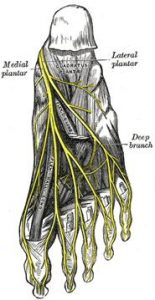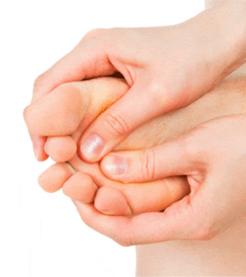The Causes And Treatment Of Morton’s Neuroma
What is Morton’s Neuroma, and how does it affect you?
Causes and Treatment of Morton’s Neuroma
Morton’s Neuroma, commonly known as Morton’s Metatarsalgia, is a disorder that affects the nerves that supply sensation to the area between the base of the toes (usually between the third and fourth toes). It’s marked by a thickening of the tissue around the nerves, and it affects more women than males.

Morton’s neuroma is caused by a variety of factors.
Morton’s neuroma is produced by long-term pressure on one of the plantar digital nerves, which can be caused by injury, inflammation, compression, or other factors (nerves that lead to the toes). The repetitive stress generates a response that leads the nerve tissue to thicken (neuroma). Morton’s neuroma is a condition that affects women who habitually wear high-heeled or narrow shoes, which squash, irritate, strain, or compress the nerves between the toes. Morton’s neuroma can be caused by high-impact activities like jogging or running, as well as many sports in general, because these activities, or the footwear required for them, can exert a lot of strain on the ligaments. Morton’s neuroma is also more common in patients with certain foot deformities, such as bunions, flat feet, and hammer toes, because these disorders can cause the ligament to apply pressure on the nerve.
What are the signs and symptoms?
Causes and Treatment of Morton’s Neuroma Symptoms might range from mild to severe. You can feel as if you’re standing on a stone or a crumpled or wrinkled sock inside your shoe. An strong ache in the ball of your foot that extends into your toes is also possible. Another common symptom of Morton’s neuroma is tingling or numbness in the toes or ball of the foot.
It may appear that there is a protuberance or swelling between the toes at times.
Another common symptom of Morton’s neuroma is the sensation that your toes are asleep.
Finally, you may notice that your toes are cramping or that you get a clicking feeling when you walk.

To read more about how IDEASTEP shoes can help with Morton’s neuroma pain, click here.
What therapy alternatives are available?
While Morton’s neuroma will not go away on its own, you can take steps to relieve pain and improve the quality of your foot. Symptoms may even go away completely in certain cases.
Purchasing suitable footwear is one of the most significant steps you can take to help decrease Morton’s neuroma-related foot discomfort. This includes looking for shoes with strong arch support and a wide toe box so your toes may expand out. IDEASTEP shoes, which are biomechanically constructed with unique therapeutic qualities, have proven to be particularly successful in reducing pain and discomfort associated with Morton’s neuroma.
The following are some treatment options that you can pursue on your own:
keeping a healthy body weight
avoiding activities that create pressure on the foot, at least momentarily
massage the affected toes and foot
putting the foot down
application of an icepack to the afflicted region
There are also specific exercises you may do to strengthen the arch’s strength and flexibility. Exercises that stretch the Achilles muscle, calf, lower leg, and plantar fascia along the bottom of the foot, as well as exercises that strengthen foot muscles in general, are included. The following are some of these exercises:
1. Take one hand and place it on the heel of your foot, while the other goes under the ball of your foot and toes. Pull the front of your foot and toes toward your shin slowly and gently.
2. Roll your foot back and forth over a bottle on the floor to stretch it.
Morton’s neuroma can also be treated with over-the-counter (OTC) drugs and injections. Corticosteroid injections or alcohol sclerosing injections are two options for injections. The first helps to alleviate pain and inflammation. The latter can aid in the reduction of the neuroma as well as pain relief.
While surgery is normally beneficial, most doctors recommend that Morton’s neuroma patients exhaust all other treatment options first, because surgery can result in permanent numbness of the affected toes.
Related Post:
Hot blogs:
The Easiest Custom Insoles: Heat Moldable Insoles
Custom insoles, also known as orthotic insoles, are designed to provide personalized support and comfort for individuals with various foot conditions. In [...]
Children’s Insole Size Conversion Chart
The standard sizes for shoe insoles may vary from country to country, making it a headache to choose the right insole for [...]
Do custom orthotics need to be made by a doctor personally?
Custom orthotics do not necessarily need to be made by a doctor personally. While doctors, specifically podiatrists or orthopedic specialists, are often [...]
Do NBA players use custom insoles?
Custom insoles are not only helpful for people with foot health issues, but they also play a significant role in targeting the [...]
